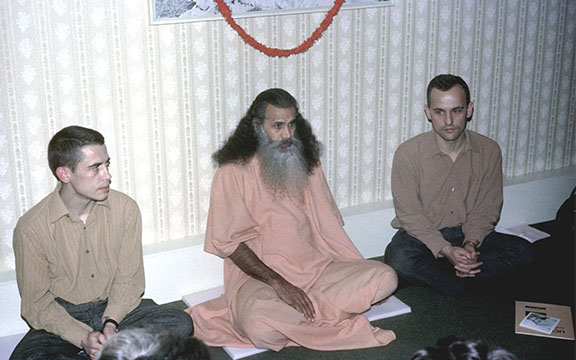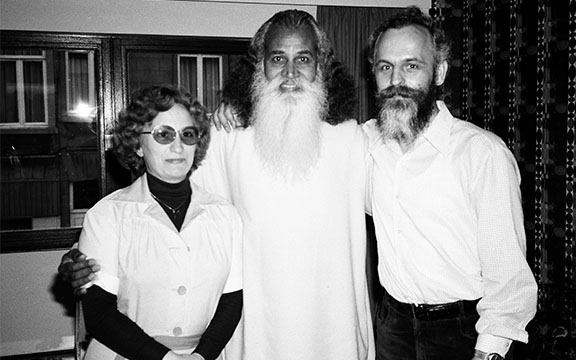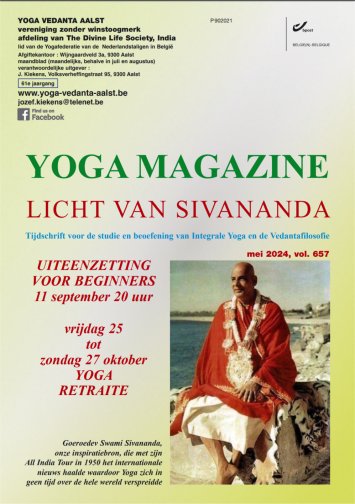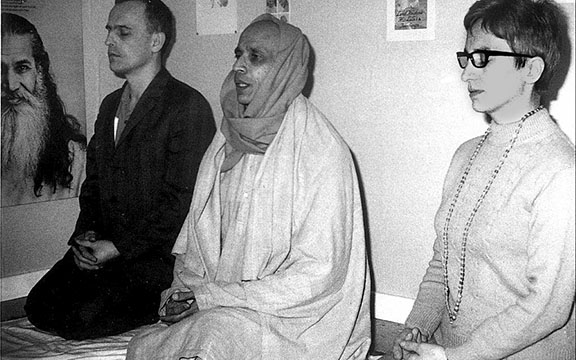
Photo: (L-R) Siva Kiekens, Swami Satchidananda, Narayana Kiekens, Aalst, Belgium, 1966.
“If you ask me ‘What is Yoga?’ the only reply I can think of is: Yoga is a state of grace.”
These words by Narayana Kiekens distill a life wholly devoted to the spirit of Yoga and the teachings of his Gurus. For more than six decades, Narayana—alongside his wife Lakshmi—dedicated himself to spiritual practice, teaching, translation, and selfless service. A disciple of Sri Swami Sivananda and Sri Swami Chidananda, and a beloved devotee of Sri Swami Satchidananda, Narayana became a pillar of classical Yoga in Europe. He passed away shortly after Guru Poornima 2025, having asked to wear the ochre robe gifted to him by Swami Chidananda, who had once told him that he would receive sannyas at the end of his life. He was 90.
Born Jozef Kiekens in Aalst, Belgium just before World War II, Narayana’s early life was marked by hardship. A serious intestinal condition at age 14 led to chronic inflammation that lasted into adulthood. But in 1959, a printed Yoga course changed everything. His wife secretly enrolled him in the class, which began with simple postures and breath awareness. Remarkably, within three months his health condition vanished—and so began a spiritual awakening that would shape the rest of his life.
The Yoga course eventually stopped after the tragic death of its teachers. Searching for further guidance, Narayana and his brother Siva discovered a book on Yoga that referenced Swami Sivananda. With no more detail than “Swami Sivananda, India,” they wrote to him. To their astonishment, within two weeks they received a personal reply dated December 6, 1962. Swami Sivanandaji wrote: “I see at the signs of your letter you were a Yogi in your former birth. Now you are on the path again. I will guide you. Your own Self, Sivananda.”
Encouraged by the letter, Narayana and his brother were instructed to start a branch of the Divine Life Society (DLS) in Belgium. Though reluctant at first, Narayana accepted the role of president out of love for his shy brother. That act of surrender marked the beginning of a spiritual mission that would touch countless lives.
Soon after, in 1966, came another turning point. Swami Satchidananda—then serving in Ceylon as head of the DLS branches there—was invited to Paris by American filmmaker Conrad Rooks. Before coming to the U.S., Swamiji asked for contacts affiliated with DLS in Europe and received the Kiekens’ address. Narayana recalled sending a ticket to him from Paris to Aalst. There they welcomed him and hosted him in Aalst. “He stayed two weeks in our place,” Narayana shared. “We organized lectures in the town hall, satsangs, and Yoga classes. He was very much impressed by our work and knowledge.”

Photo: Lakshmi & Narayana with Swami Satchidananda, Aalst, late-1970s.
This marked the beginning of a deep and joyful spiritual connection. Swami Satchidananda initiated Narayana and Lakshmi with mantra diksha and gave them their spiritual names. Narayana described how his wife dreamt of attaching her little car to Swamiji’s speeding vehicle, honking in panic as he raced ahead. She awoke drenched in sweat. “What does it mean?” she asked. Narayana replied, “He is your Guru, but what he asks of you is a bit too much.” And yet, they both joyfully accepted the path.
Swamiji visited the Kiekens family often when traveling through Europe and stayed in their home. Lakshmi Ma took care of all his needs and delighted in being called “Mataji” by him. Swamiji taught them to chant a beautiful Sanskrit verse before meals, which they continued throughout their lives. “Food is God-made,” he once reminded Narayana during a meal when Narayana glanced at his watch, “and a watch is man-made. When you are doing God’s work, forget man’s work.”
The bond between Swami Satchidananda and the Kiekens family was enduring. They visited him in the U.S. at both the Connecticut and Virginia Ashrams. At one evening satsang, Swamiji stood between Narayana and Lakshmi and said affectionately, “These are my oldies.” When Swamiji spoke in Europe or America, he praised the work being done in Aalst. When Swamiji was giving talks in Aalst or Zinal, Narayana always served as his translator from English into Dutch. His presence helped anchor the authenticity of their teachings, and they in turn helped establish his presence in Europe.
In 1970, Narayana and Lakshmi founded a formal teacher training program in Belgium—500 hours per year over four years. They taught the Yoga Sutras, Bhagavad Gita, Vivekachudamani, Hatha Yoga texts, anatomy, Ayurveda, and more. “We teach them not to make their Yoga into an academic enterprise,” Narayana explained, “but into an experiential search. People must discover that the source of the creative force is within.”

Photo: Cover of an issue of “Light of Sivananda,” published by Yoga Vedanta, Aalst
Their devotion caught the attention of Swami Chidananda, President of the Divine Life Society, who visited their humble ashram—then a modest apartment—and bowed low in full prostration before their altar. “Then he sat upright and sang Gurudev’s ‘Song of Meditation,’” Narayana recalled. “I was so impressed I thought to myself, I must learn this too.” Swami Chidananda eventually named their center the “Swami Sivananda Yoga Ashram.” Lakshmi Ma, ever devoted, typed their monthly Yoga Vedanta magazine for 15 years after being gifted a typewriter by Swami Chidananda with the encouragement, “You can learn.”
Later, when local halls could no longer be heated due to the oil crisis, they converted an old shoe factory into a warm and welcoming Yoga shala. Swami Satchidananda quipped, “They are already taking care of the soles—and souls—of the people!”
Their spiritual commitment also led them to play a founding role in the European Yoga Union. When Gerard Blitz invited Swami Satchidananda to the first international Yoga week in Zinal, he agreed—on one condition: that Narayana also be included. Thus, Narayana became one of the founding members of the European Yoga Teachers’ Federation.
Throughout their lives, Narayana and Lakshmi kept up a rigorous spiritual discipline. Rising at 4:30 a.m., they engaged in japa, meditation, and study. Narayana translated many foundational scriptures into Dutch: the Bhagavad Gita, the Yoga Sutras, the Vivekachudamani, the Vishnu Sahasranama, and several works by Swami Sivananda. He emphasized that the true teachings of Yoga lie in the mahavakyas: Pragnyaanam Brahma – Everything is Consciousness. “Tat Tvam Asi” – Thou art That. “Ayam Atma Brahma” – This Self is the Absolute. “Aham Brahmasmi” – I am That. “Between the third and fourth there is a gap,” he said. “That is the domain of sadhana.”
He traveled to India 15 times, his first trip being in 1973. When he expressed a desire to visit Benares, Swami Chidanandaji sent his own personal assistant, Swami Vimalanandaji, to escort him. Upon arrival, they were welcomed by Swami Chidananda himself, who had traveled from Haridwar just to receive them and offer personal darshan. “I felt at home from the first moment,” Narayana said.

Photo: Swami Chidanandaji’s first visit to the Kiekens’ Yoga Vedanta Centre late 1960s.
Yoga in the modern world, Narayana believed, had strayed from its roots. “Now people have a tennis day, a swimming day, a sauna day, and a Yoga day,” he lamented. “But Yoga is not a lifestyle accessory. It is a way of life, a remembrance of our divine nature.”
After the loss of his beloved Lakshmi not long ago, Narayana’s health began to decline. But his spirit remained steady and full of grace. Just before leaving his body, he prepared for the Guru Poornima celebration with devotion. He asked for his head to be shaved and wore the orange robe from Swami Chidananda. His transition came peacefully, surrounded by family, after only three weeks of illness.
Narayana and Lakshmi Kiekens are among the great lay renunciates of modern Yoga—householders who lived as saints. Their devotion to their Gurus, their wisdom, humility, and immense labor of love shaped generations of European Yoga seekers and built enduring bridges between East and West.
They are deeply missed, but the seeds they planted continue to grow. May their radiant example be a blessing and inspiration to all sincere students of Yoga.

